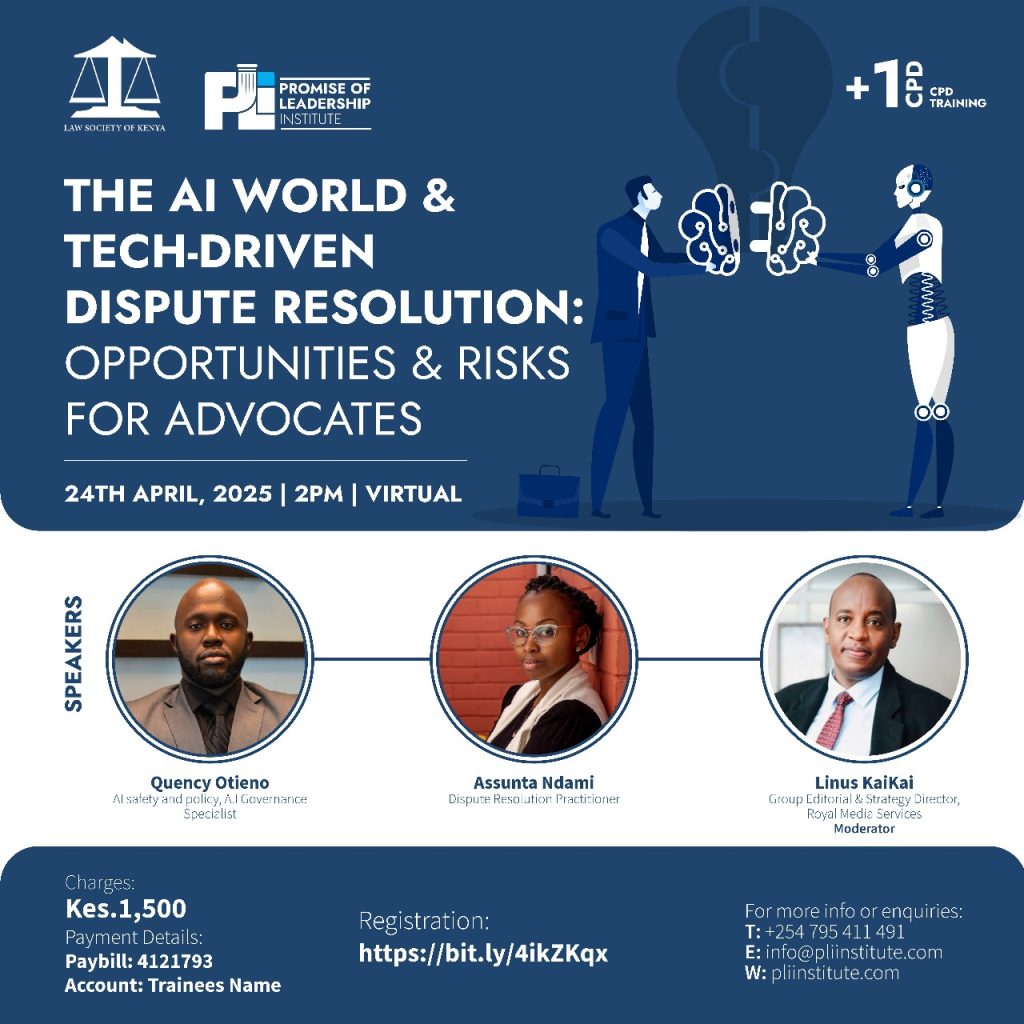The power-packed webinar held on 24th April focused on the potential opportunities and risks associated with AI, particularly in the legal field, with panelists Quency Otieno – an AI safety and policy, & Governance Specialist and Assunta Ndami – Dispute Resolution Practioner and moderated by Linus Kaikai – Group Editorial & Strategy Director at Royal Media Services, presenting on the topic. They discussed the concept of AI, its practical applications, and the legislative frameworks surrounding its use. The panelists also highlighted the potential risks and opportunities associated with AI. The meeting was interactive, with participants encouraged to ask questions and engage in discussions.
Summary
AI in Legal Field Discussion
In the meeting, Linus introduced the topic of AI and its potential opportunities, despite some concerns raised by intelligence chiefs. The discussion was led by two panelists, Quency and Assunta, who presented on the topic of AI in the legal field. They discussed the concept of AI, its practical applications, and the legislative frameworks surrounding its use. The panelists also highlighted the potential risks and opportunities associated with AI. The meeting was interactive, with participants encouraged to ask questions and engage in discussions.
AI Governance and Regulatory Frameworks
Quency discussed the concept of AI governance, focusing on the role of law in this process. He highlighted the importance of balancing innovation with governance mechanisms and the need for expertise in AI safety governance. Quency also discussed the regulatory frameworks for the EU, UK, African Union, and US, emphasizing the need for sector-specific guidelines. He touched on the importance of data protection and privacy, particularly in the context of AI-driven discrimination. Quency also mentioned the need for increased focus on transparency and explainability in AI decision-making processes. He concluded by mentioning some AI tools used in the dispute resolution space.
Adapting Legal Practices to AI
Quency and Assunta discussed the changing landscape for legal practitioners, emphasizing the need to adapt to new technologies. They highlighted the importance of understanding AI in everyday life, using examples like ChatGPT and Microsoft Copilot. Assunta noted that the internet has been evolving since the 1990s, and many attempts to merge law and technology have failed. She recommended that lawyers ask themselves if they are providing affordable, appropriate, and available services. Assunta also discussed the guidelines set by institutions like the American Arbitration Association and the International Centre for Dispute Resolution, emphasizing the importance of considering partnerships or amalgamations with law firms.
Guidelines Evolution and Knowledge Management
Assunta discussed the evolution of guidelines for alternative dispute resolution, focusing on the increasing complexity and depth of these guidelines. She highlighted the importance of knowledge management, particularly in larger firms, and its application in synthesizing legal information. Assunta also touched on the use of technology and AI in risk analysis and learning and development, emphasizing the potential for legal practitioners to leverage these tools to enhance their services.
Legal Practitioners in AI Space
Quency and Assunta discussed the opportunities for legal practitioners in the AI space, particularly in dispute resolution. They highlighted the need for more lawyers to understand and specialize in emerging technologies. Assunta mentioned the potential for legal activism and social media listening, as well as opportunities in maritime matters. Quency emphasized the importance of lawyers becoming experts in AI-related issues quickly and contributing to the development of legal precedents and policy drafts. They also mentioned the potential for advisory services in AI policy advice.
AI Concepts for Lawyers and Governance
Quency discussed the importance of understanding AI concepts and terminologies, particularly ISO 22.9.8.9 and ISO 4.2.0.0.1, for lawyers in their day-to-day practice. Quency also highlighted the need for cross-disciplinary collaboration with scholars, policy experts, and AI safety specialists. He emphasized the importance of developing a reparations framework for the global South and the need for continuous education and curricula development around AI for lawyers. Quency also mentioned the role of an AI officer in governance and compliance.
AI’s Role in Dispute Resolution
Quency discussed the vastness of AI roles and the need for more conversations about it. Assunta emphasized the importance of not relying too heavily on technology, as it could lead to a lack of human innovation and reduce human connection. She also mentioned the potential for AI systems to mediate or arbitrate matters, but noted that humans always win when it comes to human connection. Linus opened the floor for questions, and participants including Margaret raised concerns about the risk of using AI for dispute resolution, including cybersecurity and the potential for hacking. Quency responded by explaining the need for compliance and the importance of disclosure when using AI in dispute resolution processes.
Addressing AI Bias in Media
In the meeting, Linus discussed the limitations of algorithms in achieving fairness and their potential for bias. Quency then shared insights from a book about AI, emphasizing the importance of understanding the origins of coded libraries and their potential for bias. Quency also highlighted the need for developers to address these issues and the importance of learning that AI systems are not neutral. He also mentioned working on a case library for AI issues and the need for sectorial guidelines in the media industry. A participant, Gerry, asked for advice on AI strategy and its impact on dispute resolution, to which Quency responded by emphasizing the need for input from media experts and the importance of verifying the sources of information.
AI Adoption in Kenya: Challenges and Solutions
In the meeting, Assunta discussed the national policy on AI adoption in Kenya, highlighting its alignment with international trade perspectives but also expressing concerns about the digital divide and data processing. She emphasized the need for experts to document the country’s AI adoption history. Assunta also addressed the issue of AI-altered evidence in legal proceedings, suggesting the need for tech experts to verify AI’s capacity to alter evidence. Linus asked about the onboarding process for AI in law firms, to which Assunta suggested starting with case management systems, emphasizing the importance of understanding the system’s workings and data storage. She also recommended building one’s own system for better planning and understanding.
AI in Contracts and Accountability
In the meeting, Quency and Assunta discussed the importance of including AI-specific considerations in contracts and the need for accountability in AI systems. They also addressed the balance between using AI systems and training junior lawyers, with Quency suggesting that AI should complement work rather than replace it. Assunta emphasized the importance of auditing and knowledge management in the context of AI. The team also discussed the potential for special courts to handle disputes related to AI systems, with Quency suggesting that an international tribunal or body could handle such cases. Lastly, they touched on the importance of understanding contractual obligations and performance when dealing with AI-related contracts.



